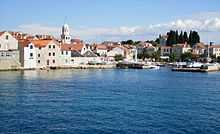Prvić
| Geography | |
|---|---|
| Location | Adriatic Sea |
| Coordinates | 43°43′48″N 15°47′42″E / 43.73000°N 15.79500°ECoordinates: 43°43′48″N 15°47′42″E / 43.73000°N 15.79500°E |
| Archipelago | Šibenik archipelago |
| Area | 2.37 km2 (0.92 sq mi) |
| Length | 3.1 km (1.93 mi) |
| Width | 1.35 km (0.839 mi) |
| Coastline | 10.63 km (6.605 mi) |
| Highest elevation | 79 m (259 ft) |
| Highest point | Vitković |
| Country | |
| Counties | Šibenik-Knin County |
| Demographics | |
| Population | 453 (as of 2001) |
Prvić (pronounced [pr̩̂v̞itɕ]) is a small island in the Croatian part of Adriatic Sea. It is situated in the Šibenik archipelago, about half a mile from the mainland, in the vicinity of Vodice. The whole island is under protection of the Croatian Ministry of Culture since the island is considered a cultural heritage.
History
The name of the island was possibly derived from Prvin, the name of the pre-Christian Croatian god of spring.[1] The other theory says that the name derives from the fact that Prvić is first ("prvi") island from the mainland in the Šibenik archipelago.
In 14th and 15th century the island belonged to noble families from Šibenik. During Ottoman conquests in 16th and 17th century, the island is inhabited by refugees from the mainland.
During World War II many of the inhabitants of the island joined the antifascist movement. Prvić was highly important in defending region against the nazi occupation. There are many antifascist monuments on the island.
Economy


Main industries are agriculture (grapes, olives and figs), fishing and tourism. The sea around Prvić is quite rich with fish. Inhabitants of Prvić are known for making a tasteful and healthful olive oil and a good wine. As mentioned, they often go fishing as well. Therefore, the Mediterranean cuisine, especially Dalmatian one is common here.
Tourism
Tourism is the most important economic branch on the island. Nevertheless, there is just one hotel on the island (Hotel Maestral*** in Prvić Luka), but locals rent their apartments, houses and villas for tourists.
Culture
There are three Roman Catholic churches on the island. Two in Šepurine and one in Prvić Luka. The smaller church in Šepurine was built in medieval times, and the bigger one in 19th century. There are many cultural events on the island during the year, such as; music concerts, art exhibitions, many sport competitions and other.
Every year on the August 2nd, there is a local celebration in Prvić Luka, and on August 16 the fešta is in Šepurine.
Villages
There are two villages on the island:
- Prvić Luka and
- Šepurine.
Its area is 2.37 km2, and it has population of 453 (as of 2001[2]) and is the third most densely populated island in Croatia.[1] Šepurine is located on the west side of the island opposite Vodice. Prvić Luka is situated in biggest bay on the south-east side and it is well protected from northern and western winds.[1]
Interesting facts
- Famous Croatian[3] bishop, inventor and polymath Faust Vrančić is buried in a church in Prvić Luka.
- In Šepurine, Faust Vrančić family had a big baroque-style summer residence which is now in possession of the Draganić family.
- Saint Ante Antić was born in Šepurine.
- There are no cars on the whole island, except a fire trucks and bicycles.
- Many ancient and medieval artifacts were found on the island.
- The coastline of the island is 10.6 km (6.6 miles) long.
See also
- Adriatic Boat Show
- City of Šibenik
- City of Vodice
- Krka National Park
- Kornati National Park
References
- ↑ 1.0 1.1 1.2 Article about Prvić on web site of local hotel
- ↑ Statistical yearbook for 2006 of Central bureau of statistics of Republic of Croatia
- ↑ Library and Waleson, John Crerar and Anthea (1984). Nature disclosed: books from the collections of the John Crerar Library illustrating the history of science. University of Chicago Library. p. 17. ISBN 978-0-943056-03-6.
External links
| Wikimedia Commons has media related to Island of Prvić (near Šibenik). |
 |
Tribunj Vodice |
Srima | Šibenik |  |
| |
Jadrija | |||
| ||||
| | ||||
| Tijat | Lupac Zlarin |
| |||||